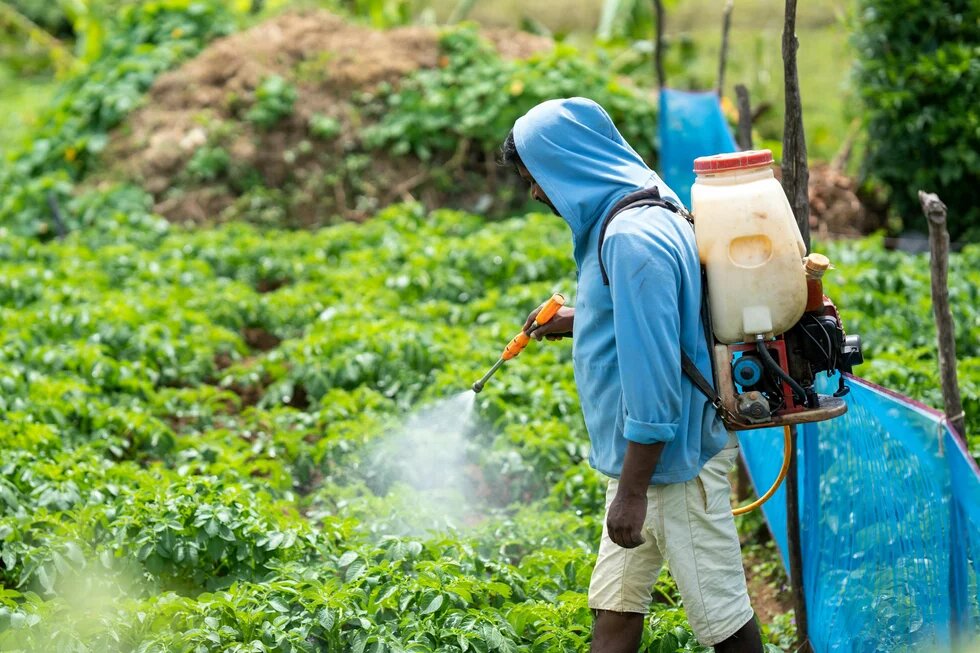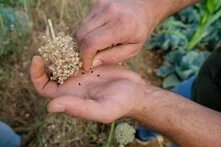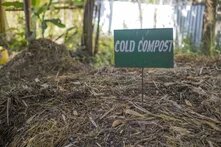The road to pesticide reform in Kenya is a story of persistence: The 2025 announcement on the withdrawal of 77 pesticides followed years of pressure from scientists, activists, and concerned citizens. But the pesticide reform remains incomplete and must go beyond banning products.

Kenya’s food system has long been caught between the dual imperatives of productivity and safety. Over the past decade, growing public concern has emerged over the widespread use of Highly Hazardous Pesticides (HHPs), many of which are banned in other countries but remain common in Kenyan markets. The increasing scientific evidence linking pesticide exposure to health risks, among both farmers and consumers, has triggered a slow but a major shift in policy discourse. The June 2025 announcement the Cabinet Secretary for Agriculture to withdraw 77 pesticide products and restrict use of 202 others represents a significant, albeit overdue, step toward aligning Kenya’s agricultural model with the right to food, environmental health, and long-term sustainability.
However, the road to pesticide reform in Kenya has not been linear. Civil society actors led by the Route to Food Initiative (RTFI), and partners including Kenya Organic Agriculture Network (KOAN), Biodiversity and Biosafety Association of Kenya (BIBA-K), Consumer Grassroot Association (CGA), Resources Oriented Development Initiative (RODI Kenya), and Kenya Parliamentary Human Rights Association (KEPHRA) have consistently pushed the envelope through research, advocacy, media engagement, and public mobilisation. Reports such as Toxic Business (2023), the Scientific Report on Pesticides in the Kenyan Market (2021), and the Pesticide Atlas Kenya Edition (2022) have unearthed both systemic regulatory weaknesses and inequities embedded in Kenya’s agrochemical dependency. These studies have sparked wide-ranging debates across media, Parliament, and policy circles, making pesticide reform not merely a technical or environmental issue, but a justice issue; one that implicates public health, gender equity, and democratic accountability in the governance of food systems.
The Roots of the Pesticide Crisis in Kenya Are Structural
Kenya’s post-independence agricultural policy was modelled around high-input, industrial farming systems, heavily reliant on chemical fertilisers and synthetic pesticides. In line with the Green Revolution logic, pest control products were introduced as a core solution to productivity deficits, and public institutions such as the Pest Control Products Board (PCPB) were established to manage this expansion. The Pest Control Products Act of 1982 gave PCPB broad powers to regulate the import, manufacture, distribution, and use of pest control products. However, the Board’s design, composed largely of government and industry representatives, has historically marginalised independent scientific voices and public participation.
Agrovet shops sold pesticides without restrictions or appropriate safety information.
Between 1986 and 2011, Kenya withdrew only 45 active pesticide ingredients, based on international conventions such as the Stockholm and Rotterdam Conventions, with little reliance on local data or public health evaluations. Until 2020, no comprehensive in-country review of registered pesticides had been undertaken. Meanwhile, reports of pesticide contamination in food and water increased, with fresh vegetables such as kale, tomatoes, and potatoes testing positive for residues of banned chemicals at public markets.
The situation was exacerbated by weak enforcement mechanisms, limited laboratory capacity, and inadequate farmer awareness. Agrovet shops, often the only point of technical advice for smallholder farmers, sold pesticides without restrictions or appropriate safety information. As public concern mounted, it became clear that pesticide policy reform in Kenya required not only institutional change but also a rethinking of whose knowledge, interests, and rights the system should prioritise.
Civil Society Advocacy and the Route to Food Campaign
Civil society in Kenya has played an indispensable role in building the case for pesticide regulation reform. The Route to Food Initiative (RTFI), in particular, has led a strategic campaign that combines research, media-communication, litigation, public awareness, and coalition-building. In 2021, RTFI supported the publication of the Scientific Report on Pesticides in the Kenyan Market, identifying 29 active ingredients registered in Kenya but already banned in Europe due to health and ecological risks. In 2022, the Pesticide Atlas Kenya Edition followed, a landmark report mapping pesticide residues in food and linking them to HHPs sold in Kenya.
Kenya had become a dumping ground for banned chemicals.
These findings were amplified through public forums, television and FM radio features, policy roundtables, and online media engagement. In 2023, RTFI launched the Toxic Business report, detailing the political economy of pesticide importation, regulatory capture, and the influence of international agrochemical firms. The report documented how Kenya had become a dumping ground for banned chemicals, many of them originating from European companies, highlighting the double standards in global agrochemical governance.
Through strategic litigation and parliamentary engagement, RTFI helped push pesticide reform onto the legislative agenda. Notably, the Parliamentary Health Committee has convened hearings in which civil society groups made strong submissions calling for a ban on HHPs. These efforts laid the groundwork for the June 2025 ministerial action, which was accompanied by public statements acknowledging the role of citizen advocacy in shaping government decisions.
In-Country Proof of the RTFI Calling: The Nyandarua Potato Study
The longstanding advocacy by the Route to Food Initiative (RTFI) around highly hazardous pesticides found empirical vindication in 2025, when Egerton University researchers published a landmark study on pesticide residues in potatoes grown in Nyandarua County, one of Kenya’s largest potato producing regions. The study, published in theJournal of Food Protection, exposed the realities of pesticide misuse at farm level. Researchers surveyed 275 farmers and tested potato samples, revealing that nearly all applied synthetic chemicals weekly, often mixing fungicides, insecticides, and herbicides without observing safety instructions. Critically, residues of banned insecticides, chlorpyrifos and fenitrothion, were detected above EU and Codex Alimentarus limits.
The reaction was swift and polarised. National media outlets amplified the findings, civil society groups pointed to this as vindication of earlier RTFI reports, while local leaders in Nyandarua accused the researchers of economic sabotage. The Senate Agriculture Committee convened urgent hearings, and calls intensified for a coordinated response to pesticide misuse, ranging from farmer training to reforming agrovet licensing and certification.
The Nyandarua potato study did more than expose a localised food safety risk; it exemplified the broader crisis RTFI has spent years raising alarms about. It also underlined the gaps in enforcement that have allowed agrochemical misuse to persist even in the face of mounting scientific evidence and policy pledges.
Regional Echoes aligned to RTFI Findings: Uganda’s Horticultural Hazard
Cross-border studies affirmed that Kenya was not alone in its challenges. A 2023 report by Wageningen Environmental Research analyzed over 700 pesticide components in vegetables from Ugandan markets, uncovering 19 different residues, including acetamiprid, profenofos, and cypermethrin, with some exceeding EU and Codex Alimentarus thresholds for maximum residue levels. A separate mixed-methods study in Kampala, Uganda’s capital, recorded pesticide residues in 95.6 percent of farm-to-market produce samples, including organophosphates like volta, entrephate, and acephate; carbamates; pyrethroids; and neonicotinoids such as imidacloprid.
Pesticides continue to circulate long after being banned in key export markets.
What makes this study especially relevant to Kenya is how closely its findings align with the evidence and policy asks presented by the Route to Food Initiative (RTFI). In both contexts, there is a discernible disconnect between policy intent and market realities. Pesticides continue to circulate long after being banned in key export markets, and both smallholder farmers and consumers remain largely unaware of the health implications of residue accumulation.
Moreover, this regional perspective reinforces the structural argument advanced by food justice advocates: that pesticide governance in East Africa requires not only stronger laws, but also a fundamental realignment of agricultural development strategies. As such, both Uganda and Kenya have embraced market-oriented horticulture as a path to food security and rural incomes, but without sufficient safeguards, these very markets have become conduits for chemical contamination.
Importantly, Uganda’s horticultural hazard is a mirror to Kenya’s pesticide dilemma. It affirms the justice claims embedded in RTFI’s work - not as isolated grievances, but as part of a systemic pattern across the region. Regional solidarity, knowledge-sharing, and harmonised reforms are now critical for building a food system that leads to production of safe food that is friendly to the farm ecosystem and socially just.
Partial but Symbolic Shift of Government Response
The 2025 announcement on the withdrawal of 77 pesticides and restriction of 202 others was a landmark move. It followed years of pressure from scientists, activists, and concerned citizens. The decision was informed by provisions in the Business Laws (Amendment) Act of 2024, which prohibited the registration of pest control products already banned in their countries of origin. The Ministry of Agriculture finally aligned with global norms, acknowledging that pesticides banned elsewhere should not be available for use in Kenya’s food system.
The reform remains incomplete.
However, the reform remains incomplete. While the banned products are no longer legally marketable, the restricted products continue to be sold without stringent licensing, prescription, or farmer awareness protocols. There is no clear mechanism for safe disposal of banned stock, and limited public communication has been made about the rationale, risks, and alternatives. Furthermore, the PCPB continues to lack a statutory requirement for periodic review of product safety, and its composition remains largely unchanged, raising questions about long-term accountability and reform depth.
At the county level, the picture is uneven. Agriculture is devolved, and counties are expected to take the lead in extension services, pesticide awareness, and farmer support. Yet most have not developed legislation or institutional frameworks to translate this mandate into action. Extension officers remain overstretched, and agrovet shops often serve as the main, poorly regulated source of pesticide advice. A few counties stand out for progressive steps: Murang’a, through its Agroecology Law (2024), created a legal framework that links pesticide restrictions to farmer training in integrated pest management, while West Pokot’s Agroecology Policy (2025) promotes safer inputs and ecological practices. These remain exceptions, however, and the majority of counties continue to rely solely on national regulations, leaving local pesticide governance weak and inconsistent.
Linking Pesticide Policy to Food Systems Justice
At the heart of the pesticide debate in Kenya lies the question of justice. Four dimensions of food justice are particularly relevant: distributive, procedural, recognition, and reparative justice.
Distributive justice concerns how the burdens and benefits of pesticides are shared. In Kenya, smallholder farmers, farm workers, and consumers bear the health risks, while agrochemical firms reap the profits. Farming families, including women and children, are disproportionately affected, with exposure through food, water, and soil.
Procedural justice is about who gets to decide. For decades, pesticide regulation has been dominated by technocratic processes and industry-led submissions. Civil society campaigns have exposed this imbalance, calling for participatory registration processes, public access to toxicological data, and independent oversight bodies.
Recognition justice demands visibility and respect for the knowledge and experiences of marginalised groups, particularly women farmers and indigenous communities whose agroecological practices offer safer, resilient alternatives. But these voices are rarely included in pesticide policy design or implementation.
Reparative justice goes further, demanding accountability for past harms. The continued sale of HHPs in Kenyan markets, even after their ban in other jurisdictions, amounts to a form of environmental and health violence. Reparative justice requires not only policy withdrawal but investment in alternatives: farmer training, agroecological transition support by the county governments, and compensation for pesticide-related illness.
The next phase of pesticide reform must go beyond banning products.
Toward a Just Agroecological Transition
The struggle for pesticide regulation in Kenya is typical of a broader tension between industrial agriculture and human rights-based food systems. While recent reforms signal progress, they are not sufficient to deliver justice. Transformative change requires embedding agroecology, public accountability, and citizen agency at the centre of policy.
The next phase of pesticide reform must go beyond banning products. It must include safe disposal systems, agrovet regulation, farmer transition support, and localised monitoring. Counties must be equipped with legal frameworks and technical capacity to implement integrated pest management and promote ecological alternatives.
Most importantly, reform must be anchored in justice - ensuring that the right to food, health, and ecological sustainability is upheld for all. Kenya now has an opportunity to lead by example, demonstrating that food justice is not only possible, but necessary for a resilient food system.
References (Cited in Article)
- Ronner, E., Van der Poel, M., & Van Reemst, L. (2023).Exploratory study on pesticide residues on fresh vegetables from markets in Uganda. Commissioned by the Agricultural Counsellor of the Dutch Embassy in Uganda. Wageningen University & Research.
- Route to Food Initiative (RTFI). (2021). Scientific Assessment of Pesticides in the Kenyan Market. Nairobi: Heinrich Böll Stiftung.
- Route to Food Initiative & Heinrich Böll Stiftung. (2023).Toxic Business: Highly Hazardous Pesticides in Kenya. Nairobi: Heinrich Böll Stiftung.
- Ssemugabo, C., Nkuba, J., Lukwago, D., Ndejjo, R., Muwonge, A., Atuhaire, L. K., & Musoke, D. (2022). Assessment of health risks posed by consumption of fruits and vegetables with pesticide residues in Kampala Metropolitan Area, Uganda.Food Safety and Risk, 10(1), 90.
- Kanario, M., Njue, H., & Wanjiru, E. (2025). Assessment of Pesticide Residues in Potatoes in Nyandarua County, Kenya. Journal of Food Protection, 88(3), 415–427.
- Ministry of Agriculture and Livestock Development (MoALD).(2025). Press Statement on Withdrawal and Restriction of Pesticide Products. Nairobi, June 2025.
Recommended for Further Reading
- FAO & WHO. (2020). International Code of Conduct on Pesticide Management: Guidelines on Highly Hazardous Pesticides. Rome: FAO
- PAN International. (2021). List of Highly Hazardous Pesticides (HHPs). Pesticide Action Network.
- Human Rights Watch. (2023). “A Toxic Legacy”: Exposure to Hazardous Pesticides in Africa’s Agricultural Sector.
- Heinrich Böll Stiftung. (2024). Pesticide-Free Agriculture: A Farmer’s Resource Guide. Nairobi: Heinrich Böll Stiftung Kenya Office.
- European Food Safety Authority (EFSA). (2022). Cumulative Risk Assessment of Pesticide Residues in Food.
- Mutua, J., & Wafula, D. (2022).The Informal Agrovet Sector and the Challenge of Safe Pesticide Use in Kenya. Journal of African Agrarian Studies, 17(2), 221–239.
- Mahiaini, R. & Mwangome, P. (2023). Public Health Implications of Unregulated Pesticide Trade in Kenya: A Cross-Sectoral Analysis. African Journal of Food Safety, 5(1), 11–23.

